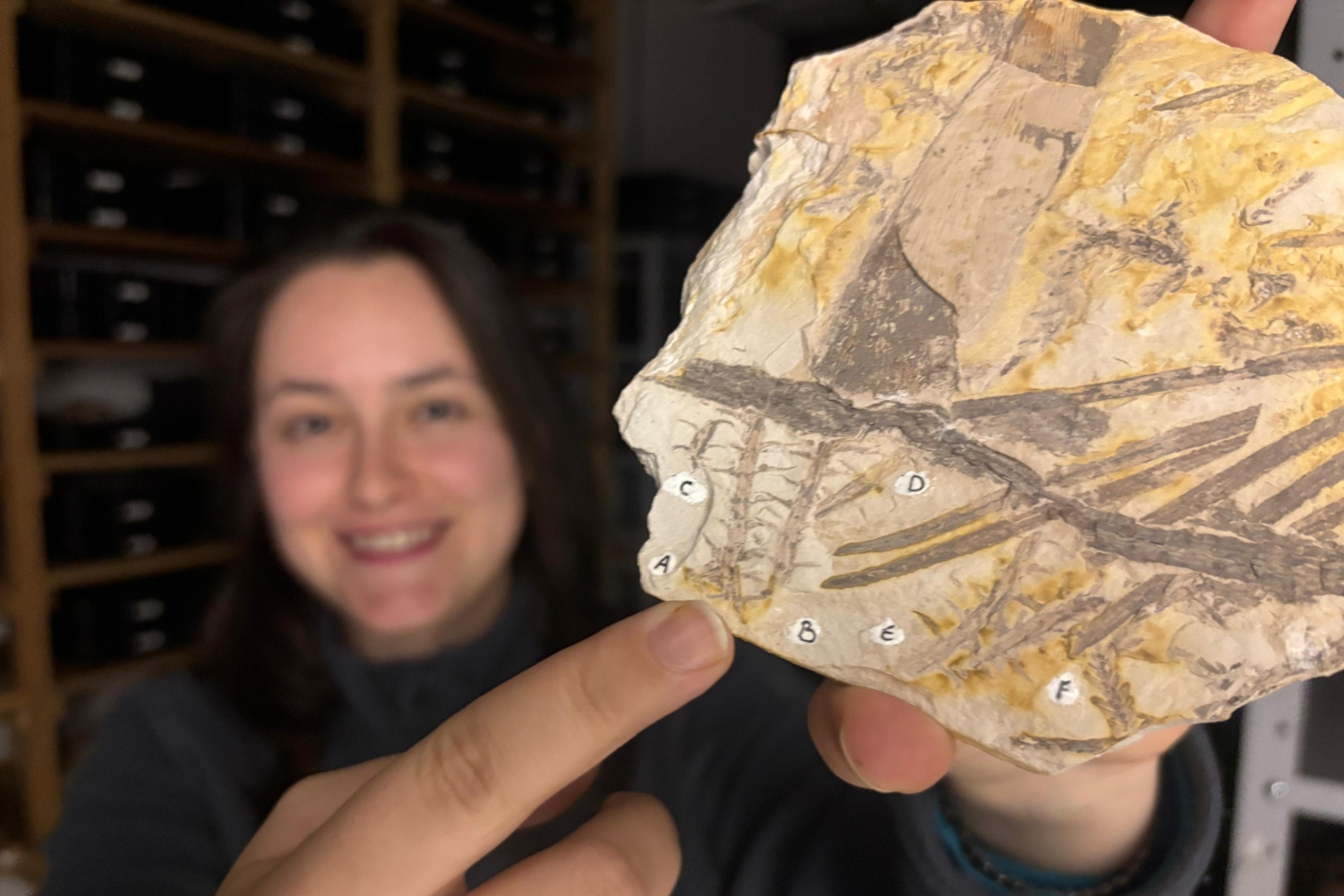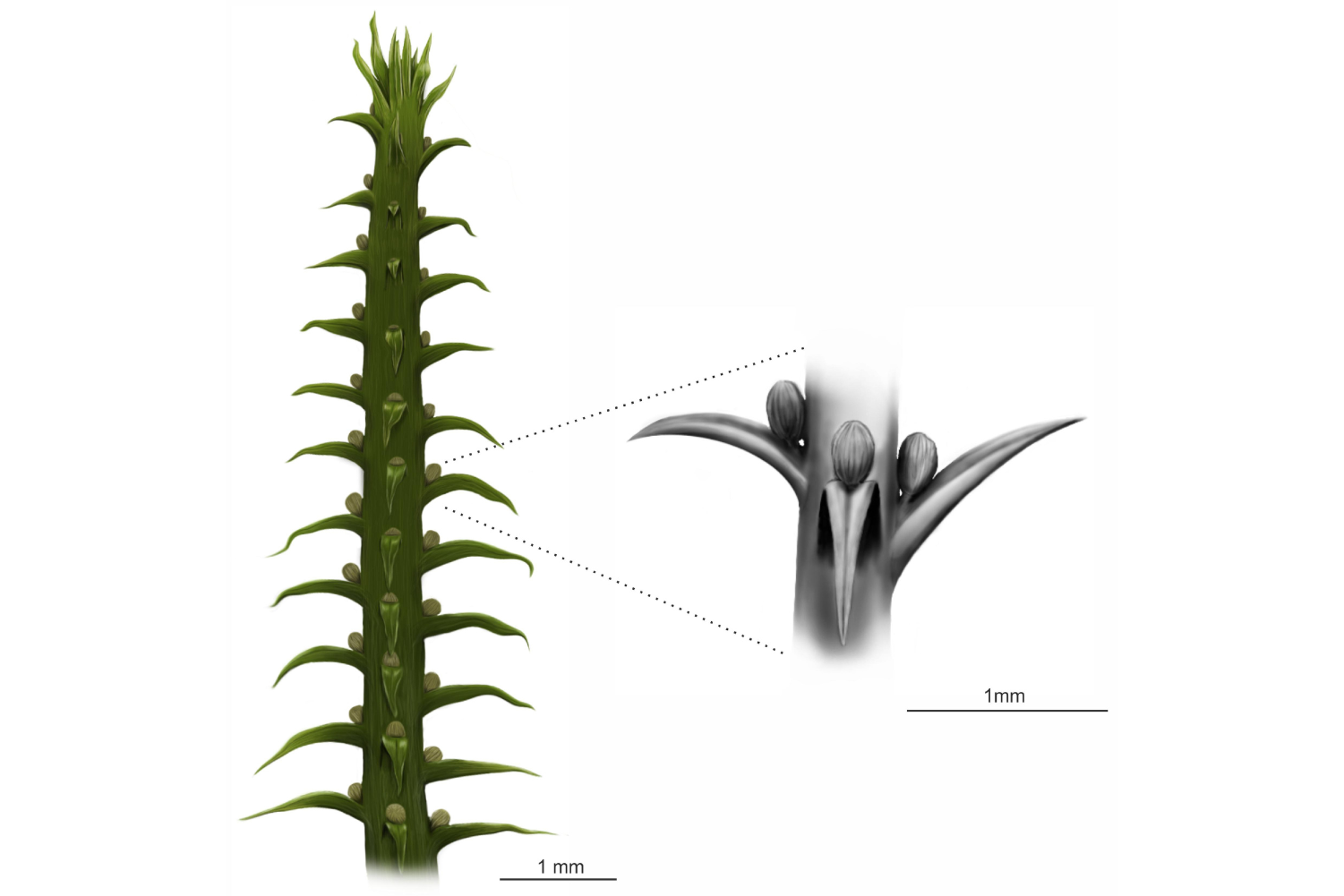296-Million-Year-Old Fossil Unearthed in Brazil Sheds Light on Ancient Plant Mystery Hidden for Over Half a Century
15.08.2025
[Due to the specialized vocabulary used to maintain the accuracy of the concepts related to the field of study, this article includes a glossary explaining the scientific terms used towards the end]
Brazilian paleobotany has just solved an enigma: the redefinition of a fossil plant described decades ago in southern Brazil and the creation of a new genus, Franscinella, to accommodate the species now called Franscinella riograndensis (Salvi et al.) Carniere, Pozzebon-Silva, Guerra-Sommer, Uhl, Jasper et. Spiekermann comb. nov. The study is part of the master's thesis by Júlia Siqueira Carniere, currently a doctoral student in the Graduate Program in Environment and Development at Univates (PPGAD). The article, recently published in the scientific journal Review of Palaeobotany and Palynology, reinterprets the type material previously classified as Lycopodites riograndensis and establishes the first record of lycopodites with in situ spores in the Permian strata of the Paraná Basin.
The discovery reclassifies its original taxonomy and presents a possible resolution to a scientific challenge that had persisted for more than 50 years - finding in situ plant spores preserved in Upper Paleozoic clastic rocks (between 298.9 million years and 252.17 million years) for Brazil. The feat was made possible thanks to the way the fossil material was preserved, a set of cutting-edge methodologies combining advanced microscopy techniques and an interdisciplinary collaboration between leading institutions in Brazil.
A new look at a classic fossil
The species Lycopodites riograndensis had originally been described on the basis of general macro-morphological characteristics observed in the fossil material. These analyses, made decades ago, considered the shape and arrangement of the stems, but did not have access to more detailed internal information, especially about the anatomy and spores.
With advances in microscopic preparation and analysis techniques, the team led by the University of Vale do Taquari - Univates, through the Graduate Program in Environment and Development (PPGAD) decided to revisit the standard material, which was available for study in the Univates Paleontological Collection. The aim was to investigate whether, using more refined methodologies, it would be possible to obtain unpublished anatomical and palynological data.
The work used scanning electron microscopy (SEM), vinyl polysiloxane silicone molding (VPS) and transmitted light microscopy, resources that allow surfaces and internal structures to be visualized with great magnification and detail. This approach revealed key elements that justified the taxonomic redefinition, including: isotomic branching in the stems, a typical feature of some fossil lycopsids; tracheids of the vascular cylinder with preserved structure, important for identifying extinct plant groups; and trilete spores with verrucate sculpture preserved in situ, i.e. still within the reproductive structures of the plant.
Obtaining the spores in situ was a decisive - and complex - step. The solution came with the use of the infrastructure of the itt Oceaneon Technological Institute at the University of Vale do Rio dos Sinos (Unisinos), which specializes in the recovery of microfossils - such as pollen grains, spores and marine organisms like radiolarians and ostracodes. The itt Oceaneon team applied a specific protocol for recovering spores in situ, which proved to be efficient for this type of material.
From micro to macro: connecting fossil records
The spores found in Franscinella riograndensis show morphology compatible with the palynological genus Converrucosisporites, common in Permian deposits in the Paraná Basin. This correspondence is relevant because it directly links the macrofossil record (visible parts of the plant) to the microfossil record (spores and pollen grains), broadening our understanding of past vegetation and ecosystems.
In practice, this means that researchers can now make more complete interpretations of Permian plant communities, integrating information from different lines of evidence. In addition, this correlation contributes to biostratigraphy studies, which use fossils to date and correlate rock layers.
Why is this discovery important?
The redefinition of Franscinella riograndensis shows how revisiting known fossils with new tools can generate groundbreaking discoveries. Many fossil groups, such as lycopodids, have historically been classified under broad, generic genera, in this case Lycopodites. This type of umbrella classification was a practical solution in the absence of more detailed information, but tends to be revised when new data becomes available.
The work also highlights the importance of national technological infrastructures and collaborative work between researchers and institutions.
From a paleobotanical point of view, the recording of lycopsids with spores in situ in the Paraná Basin opens up new perspectives for reconstructing the flora of the Permian and for understanding the evolution of vascular plants. From a global scientific perspective, this study contributes to the understanding of the diversity and distribution of herbaceous lycopsids during the Permian in Gondwana, being only the fifth known record, which makes this type of occurrence rare. In addition, it allows comparisons with similar records in other regions of the world, offering new data on the evolution and ecology of these plant groups in the Paleozoic.
The path of the research: institutions and funding
The research was led by scientists from Univates, with decisive participation from itt Oceaneon/Unisinos in the palynological preparation. The work also included contributions from the Federal University of Rio Grande do Sul - UFRGS and researchers from international institutions such as Senckenberg in Germany. Júlia Siqueira Carniere, Ândrea Pozzebon-Silva, Rafael Spiekermann, Lilian Maia Leandro, Margot Guerra-Sommer, Dieter Uhl and André Jasper.
Technical support from Tecnovates (Univates Science and Technology Park) was fundamental for the infrastructure and logistics stages. The project received funding from Brazilian science development agencies, including the National Council for Scientific and Technological Development (CNPq) and the Coordination for the Improvement of Higher Education Personnel (CAPES).
Glossary
Paraná Basin - A large sedimentary basin stretching across parts of Brazil, Paraguay, Uruguay and Argentina, containing rocks of various geological ages.
Biostratigraphy - Branch of geology that uses fossils to correlate and date layers of sedimentary rocks.
Converrucosisporites - A palynological genus based on the morphology of certain types of fossil spore.
Verrucate sculpture - Surface ornamentation of spores or pollen characterized by rounded, wart-like projections.
Trilete spores - Spores with a "Y" shaped mark resulting from the process of cell division in the formation of the spore.
Gondwana - Supercontinent that existed from the end of the Paleozoic to the Mesozoic, bringing together the current continents of the Southern Hemisphere, such as South America, Africa, Antarctica, Australia and India.
In situ - Latin expression meaning "in the original place"; in paleobotany, it indicates that the microfossil is preserved in the position and place of origin.
Lycopods (Lycopsida) - Group of primitive vascular plants, with current representatives such as Selaginella and Lycopodium, but much more diverse in the past.
Type material - Set of fossils or specimens used to formally describe a new species.
Transmitted light microscopy - Technique that uses light passing through the sample to reveal internal structures.
Scanning electron microscopy (SEM) - A technique that uses a beam of electrons to generate high-resolution images of the surface of a sample.
Vinyl polysiloxane silicone (VPS) molding - A method for creating detailed molds of surfaces, often used by dentists.
Upper Paleozoic - Subdivision of the geological time scale that covers the Carboniferous and Permian periods, between approximately 359 and 252 million years ago.
Palynomorphs - Microfossils of organic origin, such as pollen grains, spores and some algae.
Clastic rocks - Sedimentary rocks formed by the accumulation and compaction of fragments (clasts) of other rocks or minerals.


